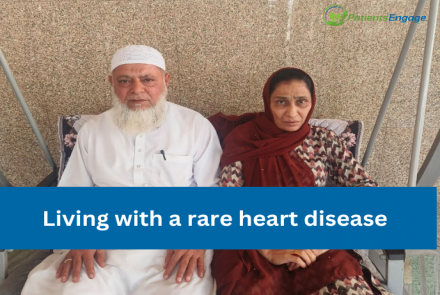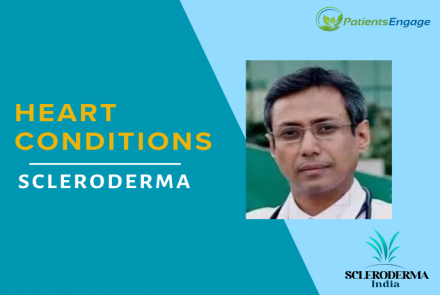
Dr Prasan Deep Rath, is the Senior Director & Head – Rheumatology at Max Super Speciality Hospital in Saket, New Delhi. He talks about how the heart is a major organ involved in Scleroderma at the Sclerocon e-conference held in June 2023. He details the layers of the heart for better understanding, the connect with lungs and how to recognise the differences between right and left heart failure. In addition, he explains how Scleroderma can affect the heart and how we can detect it on time.
Scleroderma is a disease which can affect multiple organ systems. The cardiac manifestations of this disease are diverse and only recently recognized. Up till now, we have been talking about skin, lungs kidneys but heart is a major organ involvement in Scleroderma. The presence of cardiac involvement generally portends a very poor prognosis for patients and that is why it's very important to understand and on suspicion, pick up this condition early. In fact, most of the recent studies have suggested that the clinical evidence of heart disease or myocardial disease may be seen in 20 to 25% of patients with scleroderma.
The anatomy of the heart is important to understand. There are different layers of the heart and any of these layers can get affected in Scleroderma. From outside in, there is the epicardium, myocardium and the endocardium. The outer epicardium layer is covered by the pericardium, which forms a sac where the heart lies. This sac has an outer layer and inner layer, and a small bit of fluid which provides lubrication to the heart.
Full video can be seen at https://www.youtube.com/watch?v=9T4Gsxvf1-Y
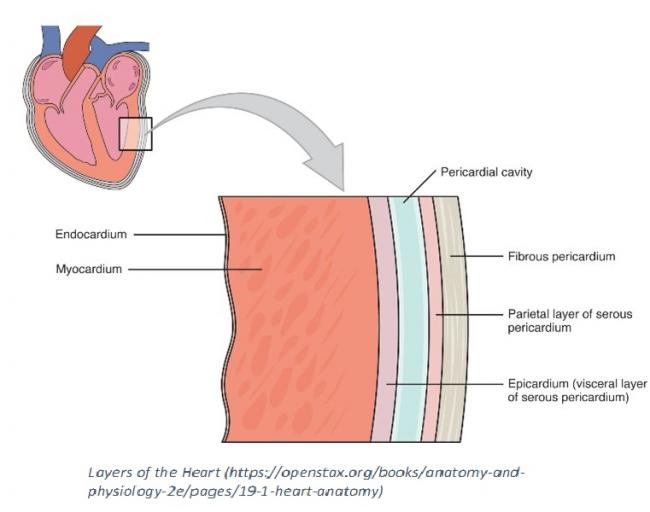
When we talk of heart diseases either there is a direct or indirect effect on the heart.
Direct effects are from:
- disease of the pericardium or the pericardial sac
- disease of the myocardium
- disease of the inner endocardium side of the heart which involves the valves
- involvement of the whole heart/chambers.
When we talk of indirect effects, we talk of effects on the heart indirectly by:
- lung diseases like interstitial lung disease (ILD) and pulmonary artery hypertension (PAH)
- kidney diseases
Pericardium
This heart image shows the pericardial sheath which is like a sac around the heart. It has an outer layer (shown in blue) and an inner layer (shown in red), and between the two layers is fluid which is called the pericardium fluid. This fluid is very minimal in normal people and as you can see again on the right image.
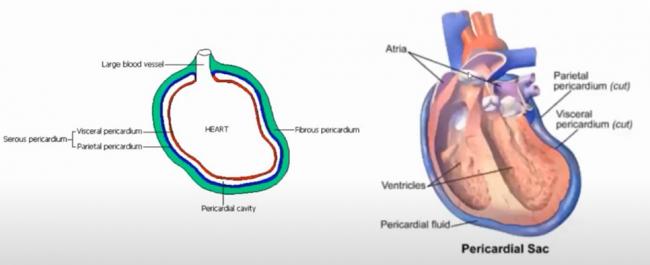
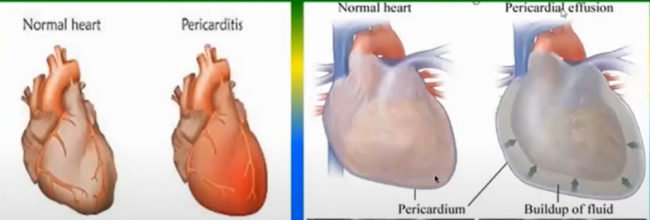
There are conditions where this sac can get inflamed or swollen and that can lead to chest pain, this is called pericarditis. Sometimes there can be huge accumulation of fluid around the heart and that fluid can constrict the heart and be very life-threatening, this is called Pericardial Effusion. So, on one hand we have pericarditis, which is inflammation of the sac, and on the other hand you have pericardial effusion, where there is lot of accumulation in the fluid which prevents the heart from contracting properly. This is in fact one of the most common involvements of heart in most of the Scleroderma patients, and often can present mainly as chest pain and/or shortness of breath. It is very important to recognize this condition.
Myocardium
Next is the muscle layer of the heart called the myocardium and this is very important for one major reason as this is the layer which contains the conductive system of the heart. The conduction system is like an electric wiring of the heart where you have a generator that emits electric impulses that go to the different chambers of the heart. That is how the heart contracts. Hence any involvement of this layer either by inflammation which we call as myocarditis or fibrosis, as we know in Scleroderma there is fibrosis everywhere; there is fibrosis in the lungs, the GI tract, and the skin. Similarly, there can be myocardial fibrosis and this fibrosis can interrupt this electrical conduction system. When this electricity conduction system is interrupted, it leads to irregular beating of the heart and the electric impulses don't travel properly. The heart doesn't beat at regular intervals; either it beats very fast something we call as tachycardia or it beats very slow something we call as bradycardia. These irregularities of the rhythm are very important to recognize. When some of these wirings go haywire you can have a very fast beating, it could be supraventricular tachycardias (SVTs) or ventricular tachycardias (VTs) and they can lead to certain arrests of the heart. The conduction system gets involved very frequently in Scleroderma.
Endocardium
Then you have the inner layer or the endocardium and the valves. Valves are present between the upper and lower chambers of the heart. The left-side valve is called as the mitral valve, and the right-side valve is called the tricuspid valve. Valve between the right ventricle and the pulmonary vessel is called the pulmonary valve. In Scleroderma it can lead to floppiness of these valves. They can become lax or very tight; so when they become lax they lead to regurgitation or the fluid kind of leaks back and when they are tight it can lead to obstruction for the outflow of the fluid. All of these things can cause various problems to the heart.
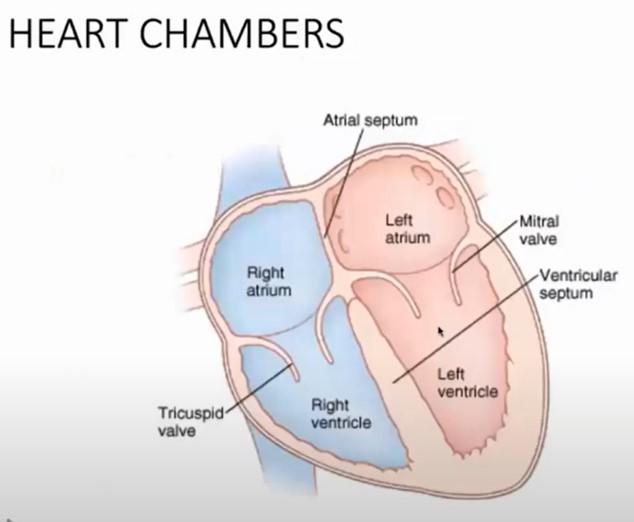
We know that there are heart chambers; there's the left heart chamber with an upper and lower chamber known as the left atrium & left ventricle. There's a right heart with an upper and lower chamber known as the right atrium and the right ventricle. Each of these chambers connect with each other through these valves. Chamber defects because of the valve or various other things can lead to either a left heart failure or a right heart failure or a combined failure.
Connection Between Lungs and Heart
Normally, the right ventricle pumps impure blood (blue blood) from the vein to the capillaries in the lungs, where it gets oxygenation (becomes red) and then returns it back to the left side of the heart. From here, it gets pumped out from where it flows to the rest of the body, so as you see the lung plays a very critical role in putting oxygen into the blood.
Read about Scleroderma and Lung Management
If this exchange is not happening properly or there is some damage to the lungs, then there can be some pressure on the right side and this can lead to right heart failure. Right heart failure is in fact a very important component in Scleroderma
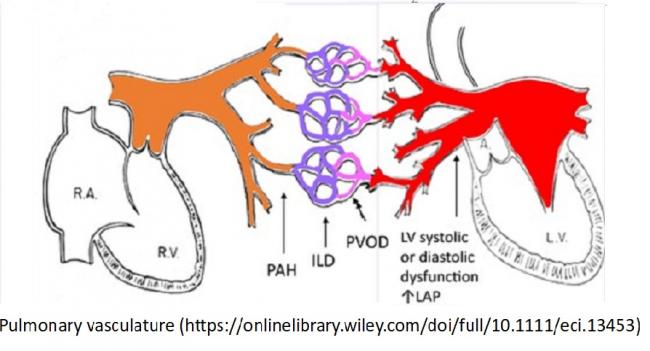
In the right side of the heart, if pressure increases in the pulmonary artery, the pre-capillary pressure also goes up and there is fibrosis. We call this as pulmonary artery hypertension (PAH). Once there is a pulmonary artery hypertension, it can cause back pressure on the heart and this back pressure on the heart can lead to lead to enlargement and failure of the right side of the heart. Similarly, if you have interstitial lung disease, these small capillaries which are supposed to provide oxygenation get obliterated and as a result causes back pressure on the heart on the right side and leads to right heart failure. There is something known as PVOD or Pulmonary veno-occlusive disease, which is a rare condition seen usually in the post capillary area. Fibrosis of these capillaries can again lead to failure of the heart. Hence any involvement of the lung in the form of pulmonary artery hypertension and interstitial lung disease can cause backflow and pressure on the right heart and cause it to fail.
Related Reading: Understanding Heart Failure
What is Right Heart Failure?
Right heart failure is commonly seen in Scleroderma patients. Symptoms can be very subtle and include loss of appetite, swelling of the lower legs known as the leg edema, fluid accumulation in severe cases in the stomach, weight gain, fatigue, enlargement of the organs like liver and spleen. These symptoms are important to recognize because this tells you that there is some problem with the right side and probably because of the lungs or the pulmonary arteries.
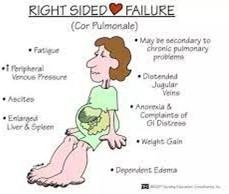
What is Left Heart Failure?
Left-sided failure is much more dramatic because the left heart plays a very important role in pumping the blood into the circulation so any left-sided failure can lead to shortness of breath while movement.
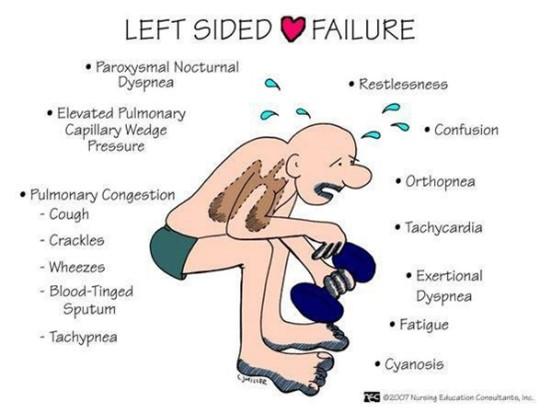
This can be confused with a lung problem whereas the lung may be normal. Other symptoms are shortness of breath in an upright position, coughing at night causing you to wake up, unable to lie down due to shortness of breath also called orthopnea. Patients will sleep at night and typically wake up in the night because of shortness of breath which is known as PND or paroxysmal nocturnal dyspnoea, which means intermittent episodes of shortness of breath at night. It can also cause palpitations, where you can have feeling of fast heart rate or you can feel your heartbeat. There will be fatigue and tiredness because the heart is not able to pump blood into the periphery so the organs are not receiving enough oxygen. Bluish discoloration of the of the tongue is seen. Shortness of breath can also cause constant cough and wheezing and sometimes even blood-tinged sputum. All these things are very similar to lung involvement and often one can miss these signs of left heart disease and confuse them for lung involvement. This can happen because it is under-looked or because it coexists with a lung disease, so it becomes very important to understand that whether the lung is the problem or the heart is the problem.
What is Raynauds of the heart?
There's a very fascinating condition which happens in Scleroderma patients and this is known as the Coronary Raynauds or Raynauds of the heart. Similar to Raynauds’s syndrome which we all know happens in the distal vessels of the fingers which constrict on exposure to cold, the blood vessels (coronaries) which are supplying the heart sometimes undergo a spasm in reaction to various triggers. This can lead to a very severe heart attack kind of a situation where there is severe chest pain and it almost mimics a heart attack except that there is no cholesterol deposition. What is happening is that the coronary arteries are undergoing a spasm. This can often be a cause of distress and recurrent admissions in patients of Scleroderma. However, on angiography nothing comes out and everything seems to be normal.
What are the investigations for these various pericardial and myocardial disease?
- 2D ECHO which is a very simple bedside ultrasound kind of a technique where we can just scan with a simple probe and look whether there is fluid in the lungs, whether there is involvement of the myocardium by myocarditis or whether the heart is properly functioning or not.
- Simple x-ray if there's a huge pericardial effusion or fluid around the heart.
- ECG is one of the best methods to see a normal rhythm and where there's a conduction abnormality or involvement of the electrical system wiring.
- Cardiac MRI which is an advanced imaging can look at the layers of the heart and pick up inflammation or fibrosis in the heart.
- Thallium perfusion imaging is a nuclear Imaging to check if the heart is getting properly perfused by blood. It can trace this particular radioisotope which is tagged. Shows if flow is normal in various parts of the heart, whether all the parts of the heart are properly contracting or there is some problem in a focal area.
- CT Angiography is more useful when there is a long-standing disease and you develop cholesterol deposition conventional but less required in Scleroderma patients because most often it's normal and what you may actually have is a coronary vasospasm known as the Raynauds of the heart.
How to Treat?
- If you have a pericardial disease such as pericarditis you give steroids or you give anti-inflammatory medication and the inflammation subsides. If fluid accumulation is present and minimal, steroids will reduce that too. Pericardial effusion is the only condition in Scleroderma where you would give high dose steroids. If fluid accumulation is severe, you need to put in a needle to drain the fluid, thereby reducing the pressure on the heart.
- For conduction defects, we have drugs to correct this known as antiarrhythmics. If that they don't correct it, then we do something called as Radio frequency ablation.
- In chamber problems, where one chamber is failing, we have medications for heart failure. For right side failure we have medications to reduce the load, for left heart failure we have medications to increase the contractility of the heart.
- If there is pulmonary artery hypertension which is causing a backflow and failure, we give medications which would indirectly also improve the right heart failure.

Dr P D RATH
MD, FACR, FRCP(Edin), FRCP(Glasgow)
FNIMS, FRCM, GCPR(UWA, AUS)
Diploma Msk Ultrasound (Ucam, Spain)
Director And Head Of Department Rheumatology
Max Super Speciality Hospital Saket, New Delhi




